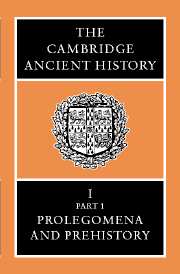Book contents
- Frontmatter
- Contents
- List of Maps
- List of Tables
- List of Text-figures
- Preface
- Chapter I The Geological Ages
- Chapter II Physical Conditions in Eastern Europe, Western Asia and Egypt Before the Period of Agricultural and Urban Settlement
- Chapter III Primitive Man in Egypt, Western Asia and Europe in Palaeolithic Times
- Chapter IV The Evidence of Language
- Chapter V The Earliest Populations of Man in Europe, Western Asia and Northern Africa
- Chapter VI Chronology
- Chapter VII (a) The Earliest Settlements in Western Asia from the Ninth to the End of the Fifth Millennium B.C.
- Chapter VII (b) Anatolia Before 4000 B.C.
- Chapter VIII The Development of Cities From Al-‘Ubaid to the End of Uruk 5
- Chapter IX (a) Predynastic Egypt
- Chapter IX (b) Palestine During the Neolithic and Chalcolithic Periods
- Chapter IX (c) Cyprus in the Neolithic and Chalcolithic Periods
- Chapter X The Stone Age in the Aegean
- Bibliographies
- Index to Maps
- General Index
- Maps
Chapter IV - The Evidence of Language
Published online by Cambridge University Press: 28 March 2008
- Frontmatter
- Contents
- List of Maps
- List of Tables
- List of Text-figures
- Preface
- Chapter I The Geological Ages
- Chapter II Physical Conditions in Eastern Europe, Western Asia and Egypt Before the Period of Agricultural and Urban Settlement
- Chapter III Primitive Man in Egypt, Western Asia and Europe in Palaeolithic Times
- Chapter IV The Evidence of Language
- Chapter V The Earliest Populations of Man in Europe, Western Asia and Northern Africa
- Chapter VI Chronology
- Chapter VII (a) The Earliest Settlements in Western Asia from the Ninth to the End of the Fifth Millennium B.C.
- Chapter VII (b) Anatolia Before 4000 B.C.
- Chapter VIII The Development of Cities From Al-‘Ubaid to the End of Uruk 5
- Chapter IX (a) Predynastic Egypt
- Chapter IX (b) Palestine During the Neolithic and Chalcolithic Periods
- Chapter IX (c) Cyprus in the Neolithic and Chalcolithic Periods
- Chapter X The Stone Age in the Aegean
- Bibliographies
- Index to Maps
- General Index
- Maps
Summary
I. LANGUAGE AND HISTORY
While it is difficult to establish a close relationship between language form and the racial or cultural characteristics of its speakers, an intimate relationship does exist between culture and language content. The study of language content needs no special justification, since the written records of antiquity are our most valuable source of information concerning the peoples and civilizations which form the object of historical investigation. But language as a formal structure, like the tools and institutions of a society, represents a kind of transmitted organism and as such falls into the category of data which can be ordered in typologically related sequences. Thus, for the historian, who is interested primarily in tracing interacting continuities, the study of the history and development of a language, apart from its use as a vehicle for oral and written traditions, provides useful and sometimes unique evidence of otherwise undiscernible ethnic and cultural affiliations.
LANGUAGE CHANGE
The evolution of a language through time is most conveniently described in terms of two distinct but related features: function and form. Limiting ourselves for the moment to spoken language, we may define the primary function of language as communication. It is virtually axiomatic that a language, in order to serve the communication needs of a given community effectively, must keep pace with cultural changes within that community. That one is static implies that the other is also static, a generally unlikely situation. The ever-changing communication needs of a community will thus be reflected in its language, and mainly in lexical content rather than in form. It is more or less irrelevant whether such changes are internal (evolutionary) or caused by some impetus from outside the community in question.
The changes which take place within the form of a language are of a very different sort and are to a great extent self-generated. The structure of a language may be described as a complex interlocking set of systems, the analysis of which may be approached at several levels. Although traditional divisions into phonology, morphology, and syntax are no longer recognized as adequate, this tripartite breakdown is still at the basis of the more elaborate modern analyses.
- Type
- Chapter
- Information
- The Cambridge Ancient History , pp. 122 - 155Publisher: Cambridge University PressPrint publication year: 1970



